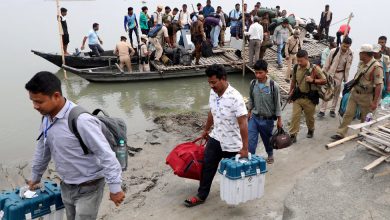The People Who Draw Rocks

Surfacing
The People Who Draw Rocks
The Alps’ glaciers are melting, and these Swiss cartographers have work to do.


Jürg Gilgen draws the first lines of the Cornettes de Bise mountain on the Swiss-French border of the Alps.
By Zoey Poll
Photographs and Video by Lucia Buricelli
Every few years, Switzerland’s national mapping agency dispatches one of its planes to scour every centimeter of the Swiss Alps, the pilot looping back and forth to capture photographs of changes in the landscape. For the most part, the modifications made to the country’s official map are minor and largely automated: a house pops up here, a funicular there. But lately, for a rarefied group of the agency’s nearly three dozen cartographers, the need for revisions has intensified.
“The glaciers are melting, and I have more work to do,” as Adrian Dähler, part of that special group, put it.
Dähler is one of only three cartographers at the agency — the Federal Office of Topography, or Swisstopo — allowed to tinker with the Swiss Alps, the centerpiece of the country’s map. Known around the office as “felsiers,” a Swiss-German nickname that loosely translates as “the people who draw rocks,” Dähler, along with Jürg Gilgen and Markus Heger, are experts in shaded relief, a technique for illustrating a mountain (and any of its glaciers) so that it appears three-dimensional. Their skills and creativity also help them capture consequences of the thawing permafrost, like landslides, shifting crevasses and new lakes.
“It’s a little bit like being a god,” Gilgen said. “You’re creating a world.”
For now, this work is still done by hand. “To update infrastructure, names or borders is quite easy, but to make climate change visible in maps is more challenging,” said Andreas Huggler, the cartography department supervisor. “It changes the physical shape of our world at a larger scale.”
At Swisstopo, it’s considered an honor to contribute to the mountains. The entrance to the office, located in Wabern, a suburb of Bern, features a gigantic map of the Alps: Inside, a map of the Blüemlisalp mountain doubles as conference-room wallpaper; the Matterhorn adorns the gift shop’s silk ties; the Dufourspitz wraps around metal water bottles.
Still, the methods are old-fashioned and time-consuming. Gilgen, Dähler and Heger are the only cartographers who use a digital tablet and stylus. While their colleagues update spreadsheets, they work directly on the map itself.“For weeks and months, you draw little lines,” Dähler explained. “At least one person tried and gave it up. You have to have a certain character.” (He recommended patience, equanimity and a genuine love of the mountains.)
To edit the Alps, the first step is to remove any extraneous glaciers. The aerial data collected by the Swisstopo plane serves as a guide. Superimposed on the old map, it shows the latest terrain overview in translucent colors. The cartographer then scrubs away any outdated shading with a digital eraser. The remaining obsolete glacier lines will stand out, like the out-of-bound scribbles in a coloring book; these are best lassoed with a cursor, a few at a time. With a tap of the delete key, the last of the ice disappears, like a typo or an unpleasant email.

Erasing and lassoing the blue contour lines of a glacier, Dähler scrubs away ice that has melted as a result of climate change.
Filling in the blank spots requires more expertise. Swiss relief shading is internationally renowned, both for its accuracy and naturalistic approach. Gilgen and his two co-workers apprenticed for four years at Swisstopo before they could even apply to draw the classic alpine terrain. For the first year they practiced only lines and ovals every morning. “You need to know how to control your hand, and even your breathing,” Gilgen explained.
One way to draw a mountain is to break it into manageable shapes, all sorts of triangles and rhombuses, and then fill in the details later. More practiced mapmakers dispense with this intermediary outline: Gilgen, for instance, draws a mountain all in one go, leaving behind a final draft as he moves across the page. The result is the same — a mountain chain composed of thousands of tiny hachures. These concise parallel lines slant in the same direction as the actual slope, preparing hikers for eventual steep climbs or plateaus. Up close, the texture of the lines also mimic the type of rock: eroded limestone (angular, rough), the land beneath a glacier (polished, steady), craggy granite (“jittery” or zitterig in German).
“We have a lot of rules,” Gilgen noted, such as the number of lines that can appear in any given two-millimeter square on the map. (Six under direct sun, seven on average, eight in the shade.) “But we have some freedom, too,” he added.
To translate a complex subject into a legible, portable format, the cartographers rely on their own instincts and imagination. “Some distortion is normal,” he explained. They take liberties with proportions and exaggerate important features at the expense of distracting ones. (A single boulder standing in for three; an extra-large glacier crevasse as a hazard warning.) For Gilgen, a successful map is spare and expressive, closer to a cartoon than a portrait.
The drawing styles across the Alps look indistinguishable to an average map-reader. But some experts at Swisstopo say they can spot key differences with the help of a magnifying glass. “It’s like handwriting,” Dähler said. “Quite regular” lines point toward Heger, his desk mate. In contrast, Gilgen, he said, has a naturally “lively” touch. As for himself, Dähler guessed that his style was a mix of the two.
It’s possible that Gilgen, Dähler and Heger will be the last people to leave a distinctive mark on these mountains. Swisstopo intends to phase out this hand-drawn practice, at least partly to save costs. The job may be fully automated in about a decade, if the technology catches up to the agency’s high standards. The map’s scree is already produced by a software program, which can scatter small stones across a hillside exponentially faster than the cartographers. (Approximately three minutes versus three days.)
In the meantime, the team keeps busy with the extra assignments generated by the melting glaciers, which make better use of their skills than the routine edits. That this professional opportunity is the byproduct of extraordinary environmental degradation is not lost on them. Gilgen enjoys the work while also worrying about its implications. Now and then, he feels particularly anxious when deleting the ice. “It’s sometimes frightening when you see such changes,” he said. “I get a scary feeling that there’s something happening that we can’t control.”
Heger and Dähler are more detached; as a rule, they avoid making judgments on the various updates that come across their desk. “Our personal views do not play a role,” Heger noted. Dähler, too, remains “quite neutral when drawing the rocks.” All the same, they see their work as an important act of documentation. “Memories of the past can fade,” as Heger observed. “National maps and landscape photos capture a moment in time.”
Surfacing is a visual column that explores the intersection of art and life, produced by Alicia DeSantis, Jolie Ruben, Tala Safie and Josephine Sedgwick.




